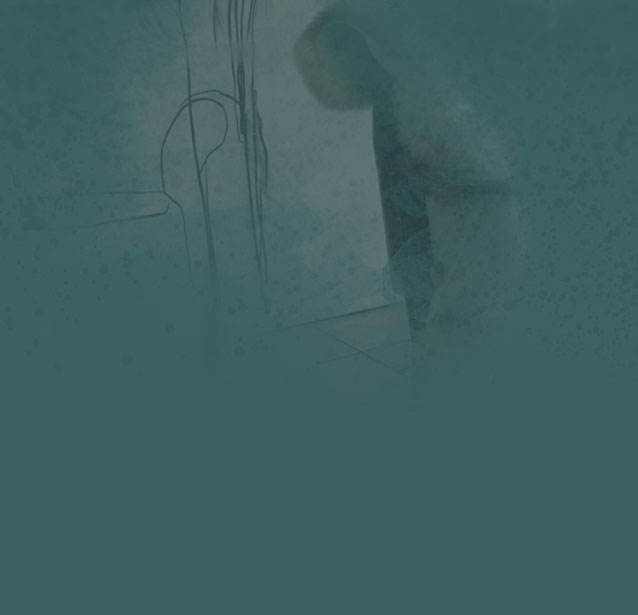Home
Decorative commissions
Håkon Gullvåg has completed a number of larger decorative commissions. Although they are spread throughout Norway, the majority are in Trondheim and Oslo. The commissions differ highly in character; Gullvåg has thrown himself into decorating churches as well as an electric company, the canteen of the internal revenue service and the wall of a house earmarked for demolition. A distinguishing feature of these decorative works is how he enters into a dialogue with the building’s form as well as its function. The works may be grouped into two main categories: church-related (ecclesiastical) commissions and secular commissions.
Ecclesiastical commissions - The Liturgical Art of Håkon Gullvåg
Gullvåg has executed almost all his liturgical artworks as oil paintings on wooden panels. These works harmonize stylistically with his general artistic oeuvre, yet their pictorial programs, iconographic content and compositions have roots reaching as far back as the Middle Ages, when church embellishment was a folk-art with a direct liturgical function.
Gullvåg stands out as a significant innovator of Norwegian liturgical art. It is not simply beauty that is prized in his works, but also their pedagogical function. The practical use of pictures in the context of the mass is instantiated through robust paintings, such that we have a visualisation to tie our thoughts on. In this way, the gospel resonates even after the mass has ended and the priest has left the church.
Secular decorative commissions
Gullvåg is an attractive artist to engage for decorative commissions; he has completed nine such projects for public buildings. His pictorial programs are each very different in expression, for each is adapted to the function of the building it decorates, everything from hotels to a house wall in danger of demolition.
A common characteristic for all his decorative works however, is their thorough preparation, including reflecting over the identity and function of the building. The essence of this preparation is reflected in his motifs. As a rule, he incorporates some of the room’s most distinguishing architectural elements into the works. These references help them to glide into the physical room in a refined manner, while the theme of the motif engages with the room or building’s “spirit”.
It must be emphasized that the decorative commissions discussed here are secular, in other words, they are not painted for churches. Gullvåg has worked extensively with church decoration, which distinguishes itself sharply from secular projects in expression as well as function. The ecclesiastical decorative programs will therefore be discussed in a separate section.
Håkon Gullvåg has completed a number of larger decorative commissions. Although they are spread throughout Norway, the majority are in Trondheim and Oslo. The commissions differ highly in character; Gullvåg has thrown himself into decorating churches as well as an electric company, the canteen of the internal revenue service and the wall of a house earmarked for demolition. A distinguishing feature of these decorative works is how he enters into a dialogue with the building’s form as well as its function. The works may be grouped into two main categories: church-related (ecclesiastical) commissions and secular commissions.
Ecclesiastical commissions - The Liturgical Art of Håkon Gullvåg
Gullvåg has executed almost all his liturgical artworks as oil paintings on wooden panels. These works harmonize stylistically with his general artistic oeuvre, yet their pictorial programs, iconographic content and compositions have roots reaching as far back as the Middle Ages, when church embellishment was a folk-art with a direct liturgical function.
Gullvåg stands out as a significant innovator of Norwegian liturgical art. It is not simply beauty that is prized in his works, but also their pedagogical function. The practical use of pictures in the context of the mass is instantiated through robust paintings, such that we have a visualisation to tie our thoughts on. In this way, the gospel resonates even after the mass has ended and the priest has left the church.
Secular decorative commissions
Gullvåg is an attractive artist to engage for decorative commissions; he has completed nine such projects for public buildings. His pictorial programs are each very different in expression, for each is adapted to the function of the building it decorates, everything from hotels to a house wall in danger of demolition.
A common characteristic for all his decorative works however, is their thorough preparation, including reflecting over the identity and function of the building. The essence of this preparation is reflected in his motifs. As a rule, he incorporates some of the room’s most distinguishing architectural elements into the works. These references help them to glide into the physical room in a refined manner, while the theme of the motif engages with the room or building’s “spirit”.
It must be emphasized that the decorative commissions discussed here are secular, in other words, they are not painted for churches. Gullvåg has worked extensively with church decoration, which distinguishes itself sharply from secular projects in expression as well as function. The ecclesiastical decorative programs will therefore be discussed in a separate section.
HÅKON GULLVÅG © / TEXTS BY DANIEL JOHANSEN AND EVA FURSETH / SITE BY KLIPP OG LIM































































